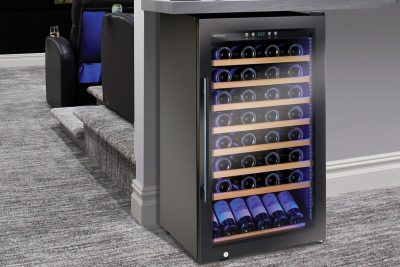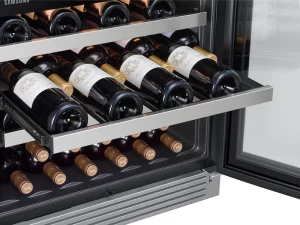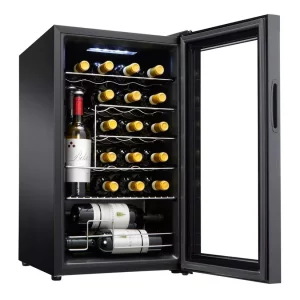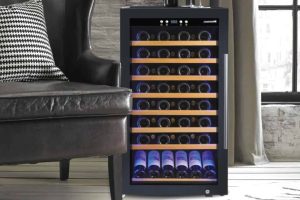“Raise a glass and cheers to perfectly chilled wine every time with a wine cooler. But what is a wine cooler? These handy appliances are a must-have for any wine enthusiast looking to keep their favorite bottles at the perfect temperature for optimal taste and enjoyment. With a variety of sizes and features to choose from, there’s a wine cooler for every collection and budget
A wine cooler, also known as a wine refrigerator, is a type of appliance used to store wine at a specific temperature and humidity level. This helps to preserve the wine’s flavor and quality, as well as prevent spoilage. Wine coolers come in a variety of sizes, from small countertop models to larger, built-in units, and can be designed to store a few bottles or several hundred.
They typically have adjustable temperature controls, allowing you to set the perfect temperature for different types of wine, and some also have features such as UV-protected glass doors to protect the wine from light damage. Wine coolers are a great way for wine enthusiasts to store and enjoy their collection at the perfect temperature.
Types of wine coolers and how they differ
There are several types of wine coolers available on the market, each with its own unique features and benefits.
- Compressor-based wine coolers: These are the most common type of wine cooler and are designed to keep wine at a consistent temperature. They use a compressor to cool the air inside the cooler, which is then circulated throughout the unit to keep the wine at the desired temperature. Compressor-based wine coolers are available in a range of sizes and can be freestanding or built-in. They are also the most expensive type of wine cooler.
- Thermoelectric wine coolers: These wine coolers use a thermoelectric system to cool the air inside the unit. They are more energy-efficient than compressor-based wine coolers and are also quieter. They are available in a range of sizes and can be freestanding or built-in. They are less expensive than compressor-based wine coolers.
- Dual-zone wine coolers: These wine coolers have two separate cooling zones, which allow you to store red and white wine at different temperatures. They are available in a range of sizes and can be freestanding or built-in. They are more expensive than single-zone wine coolers.
- Beverage coolers: These wine coolers are designed to store not only wine but also other beverages like beer, soda, and water. They are available in a range of sizes and can be freestanding or built-in. They are more expensive than single-zone wine coolers.
- Built-in wine coolers: These wine coolers are designed to be installed into a cabinet or wall. They are available in a range of sizes and are more expensive than freestanding wine coolers. They are ideal for those who want a sleek and modern look in their kitchen or wine room.
- Freestanding wine coolers: These wine coolers are designed to be placed on a flat surface. They are available in a range of sizes and are less expensive than built-in wine coolers. They are ideal for those who want a more traditional look in their kitchen or wine room.
The choice of wine cooler depends on your budget, space availability, and the type of wine you want to store. Each type of wine cooler has its own unique features and benefits, so it’s important to choose the one that best suits your needs.
The benefits of having a wine cooler in your home
Having a wine cooler in your home offers several benefits, including:
- Temperature control: Wine coolers are specifically designed to maintain the ideal temperature for wine storage. This means that your wine will always be stored at the perfect temperature, which is essential for preserving the flavor and aroma of the wine.
- Humidity control: Wine coolers also maintain the ideal humidity level for wine storage, which helps to prevent the corks from drying out and allows the wine to age properly.
- Protection from light: Most wine coolers are designed with UV-protected glass doors, which prevent harmful light from damaging the wine. This helps to preserve the wine’s color and flavor.
- Space-saving: Wine coolers are designed to be compact and take up minimal space, making them ideal for small kitchens or wine rooms.
- Organized storage: Wine coolers come with shelves or racks that allow for the organized storage of wine bottles. This makes it easy to find the wine you want and keeps your wine collection looking neat and tidy.
- Versatility: Some wine coolers come with dual-zone temperature control, which allows you to store different types of wine at different temperatures. This is ideal for those who want to store both red and white wine or different types of red wine.
- Enhancing the aesthetic appeal: A wine cooler can be a great addition to a home bar, wine room, or kitchen. It can add a touch of elegance and sophistication to any room.
- Cost-effective: Having a wine cooler in your home can save you money in the long run. By storing your wine at the correct temperature and humidity, you can prevent spoilage and prolong the life of your wine.
Having a wine cooler in your home offers many benefits, including temperature and humidity control, protection from light, organized storage, versatility, and aesthetics enhancement. It is a cost-effective way to store your wine collection properly and ensures that your wine will always be ready to drink at the perfect temperature.
How to choose the right wine cooler for your needs
Choosing the right wine cooler for your needs can be a daunting task, with so many options available on the market. However, by considering the few key factors below, you can find a wine cooler that will meet your specific needs and budget.
- Size: The first thing to consider when choosing a wine cooler is the size of your wine collection and the amount of space you have available. If you have a large collection, you will need a larger wine cooler, whereas if you only have a small collection, you can opt for a smaller cooler.
- Type: There are several types of wine coolers available, including compressor-based, thermoelectric, and dual-zone. Compressor-based wine coolers are the most common, but thermoelectric wine coolers are more energy-efficient and quieter. Dual-zone wine coolers are ideal for those who want to store red and white wine at different temperatures.
- Temperature zones: If you plan to store different types of wine, it’s important to consider the number of temperature zones offered by the wine cooler. Dual-zone wine coolers are ideal for storing red and white wine at different temperatures, whereas single-zone wine coolers are suitable for storing one type of wine.
- Additional features: Some wine coolers come with additional features such as UV-protected glass doors, built-in lighting, and digital temperature control. These features can enhance the aesthetic appeal of the wine cooler and make it easier to manage your wine collection.
- Brand and price: Lastly, it’s important to consider the brand and the price of the wine cooler. Always check the warranty, reviews, and customer service of the brand before making any purchase.
Choosing the right wine cooler for your needs requires careful consideration of several factors, including size, type, temperature zones, additional features, brand, and price. By taking the time to research your options and consider your specific needs, you can find a wine cooler that will meet your needs and budget.
Comparison between wine coolers and wine refrigerators
Wine coolers and wine refrigerators are both designed to store wine, but there are some differences between the two. Wine coolers are typically used to store wine at a consistent temperature, while wine refrigerators are used to age wine.
Below, we will compare wine coolers and wine refrigerators in a vertical format to help you understand the key differences between the two.
Wine coolers:
- Designed to store wine at a consistent temperature
- Ideal for short-term storage of wine
- Available in a range of sizes
- It can be freestanding or built-in
- Suitable for both red and white wine
- It can be used to chill wine before serving
Wine refrigerators:
- Designed to age wine
- Ideal for long-term storage of wine
- Available in a range of sizes
- It can be freestanding or built-in
- Suitable for both red and white wine
- Have a wider temperature range than wine coolers
- It can have additional features like humidity control, UV protection, and multiple temperature zones
Oveall, wine coolers and wine refrigerators are both designed to store wine, but they have some key differences. Wine coolers are typically used for short-term storage and chilling wine before serving, while wine refrigerators are used for aging wine and long-term storage.
Wine refrigerators also have additional features that make them more suitable for aging wine, like humidity control, UV protection, and multiple temperature zones.
How to properly set up and maintain a wine cooler
Properly setting up and maintaining your wine cooler is essential for ensuring that your wine is stored at the ideal temperature and humidity. Here are some steps to follow for setting up and maintaining your wine cooler:
Setting up:
- First, unpack your wine cooler and check for any damage.
- Place your wine cooler in the desired location, making sure that it’s level and on a sturdy surface.
- Allow the wine cooler to sit for a few hours before plugging it in, and this will allow any oil that may have settled during transportation to settle back into the compressor.
- Turn on your wine cooler and set the temperature to the desired level. It’s best to start with a lower temperature and gradually increase it to the desired level.
- Wait at least 24 hours before adding any wine to your wine cooler, and this will allow the temperature to stabilize.
Loading wine:
- When loading your wine, make sure that the bottles are lying down. This will keep the cork moist and prevent the wine from spoiling.
- Organize your wine bottles on the shelves or racks, making sure that they are securely in place.
- Avoid overloading your wine cooler, as this can make it difficult to control the temperature.
Maintenance:
- Clean your wine cooler regularly with a soft cloth and mild soap and water.
- Check the door seal regularly to ensure that it’s tight and intact, as a damaged seal can cause the temperature inside the wine cooler to fluctuate.
- Keep the wine cooler away from direct sunlight and heat sources, as this can cause the temperature inside the wine cooler to rise.
- Check the temperature regularly to ensure that it’s at the desired level.
Properly setting up and maintaining your wine cooler is essential for ensuring that your wine is stored at the ideal temperature and humidity.
This includes unpacking and leveling the wine cooler, waiting for the temperature to stabilize before adding wine, organizing your bottles, cleaning the cooler regularly, checking the door seal, and keeping the wine cooler away from direct sunlight and heat sources.
By following these steps, you can ensure that your wine is stored properly and will be ready to enjoy at the perfect temperature.
The importance of temperature control in a wine cooler
Temperature control is crucial in a wine cooler because wine is sensitive to temperature fluctuations. When wine is stored at a temperature that is too warm, it can cause the wine to age too quickly, resulting in a loss of flavor and aroma.
On the other hand, storing wine at a temperature that is too cold can cause the wine to become too stiff, also affecting its flavor and aroma.
The ideal storage temperature for wine is between 45-65°F (7-18°C). Reds should be stored at the lower end of this range, and whites and sparkling wines should be stored at the upper end. Maintaining the correct temperature will preserve the wine’s flavor and aroma, allowing it to develop and mature as intended by the winemaker.
Additionally, a wine cooler with a dual-zone temperature control feature allows you to store reds and whites at their optimal temperatures separately. This way, you can ensure that each wine will be preserved in its best condition.
Furthermore, temperature control is important in a wine cooler because it helps to preserve the wine’s flavor and aroma by maintaining the ideal storage temperature and preventing fluctuation. Dual-zone temperature control is a feature that can help to store different types of wines at their optimal temperatures.
Best wine cooler brands and models on the market
There are several reputable brands and models of wine coolers on the market; some of the popular and highly rated ones include:
- NewAir – NewAir offers a wide range of wine coolers, including freestanding, built-in, and dual-zone models. The NewAir AWR-290DB is a highly rated and versatile 29-bottle wine cooler that can be built-in or freestanding and has a dual-zone temperature control feature.
- Whynter – Whynter is a well-known brand in the wine cooler industry; their coolers are known for their energy efficiency and durability. The Whynter WC-201TD is a highly rated 20-bottle wine cooler that is thermoelectric and has a built-in touch control and display.
- Wine Enthusiast – Wine Enthusiast is a well-known brand in the wine industry and offers a wide range of wine coolers, including freestanding, built-in, and dual-zone models. The Wine Enthusiast VinoView is a highly rated and versatile wine cooler that can store up to 18 bottles and has a double-pane insulated glass door.
- Danby – Danby is a reputable brand in the wine cooler industry; they offer a wide range of wine coolers, including freestanding, built-in, and dual-zone models. The Danby DWC518BLS is a highly-rated wine cooler that can store up to 18 bottles and has built-in temperature control and LED lighting.
- Koldfront – Koldfront is a reputable brand in the wine cooler industry, and they offer a wide range of wine coolers, including freestanding, built-in, and dual-zone models. The Koldfront TWR187ESS is a highly-rated wine cooler that can store up to 18 bottles and has built-in temperature control and LED lighting.
It’s worth noting that the best wine cooler for you will depend on your specific needs and preferences, such as the number of bottles you want to store, the size of the cooler, the design, and the features you need. It is recommended to read the reviews and compare the features of different models before making a purchase.
How wine coolers differ from traditional refrigerators
Wine coolers and traditional refrigerators are both designed to keep food and beverages at a certain temperature, but they have some key differences.
- Temperature range: Wine coolers are specifically designed to store wine at the optimal temperature range of 45-65°F (7-18°C), while traditional refrigerators are designed to keep food at a much colder temperature range of 33-40°F (0.5-4°C).
- Humidity control: Wine coolers are designed to maintain a humidity level of 50-70% to prevent the corks from drying out, which can lead to oxidation and spoilage of the wine. Traditional refrigerators do not have this feature.
- Shelving and storage: Wine coolers typically have shelves that are designed to hold wine bottles in a horizontal position, which helps to keep the cork moist and prevents the wine from spoiling. Traditional refrigerators have shelves that are typically designed to hold food items in a vertical position.
- Size and design: Wine coolers are typically smaller in size than traditional refrigerators, and they are designed to fit in specific areas, such as under the counter or in the corner of a room, while traditional refrigerators come in a variety of sizes and designs, and can be placed in a variety of locations.
- Dual-zone temperature control: Many wine coolers are designed with dual-zone temperature control, which allows you to store different types of wine at different temperatures in the same cooler. Traditional refrigerators do not have this feature.
Wine coolers are specifically designed to store wine at the optimal temperature range, with humidity control and shelves that hold wine bottles horizontally.
At the same time, traditional refrigerators are designed to keep food at a much colder temperature range, with different shelving designs, and typically do not have humidity control features.
How to use a wine cooler to properly age wine
Properly aging wine can greatly enhance its flavor, aroma, and overall quality. Here are some steps you can take to use a wine cooler to age wine correctly:
- Set the temperature: Set the temperature of your wine cooler to the optimal range for aging wine, which is between 45-55°F (7-13°C) for red wines and between 45-50°F (7-10°C) for white wines. This will ensure that the wine is stored at the ideal temperature for aging.
- Control the humidity: Keep the humidity level inside the wine cooler at around 50-70%. If the humidity is too low, the cork can dry out, allowing air to enter the bottle and spoil the wine. If the humidity is too high, mold can form on the cork.
- Store wine horizontally: Store the wine bottles horizontally in the wine cooler. This helps to keep the cork moist and prevents air from entering the bottle.
- Limit light exposure: Keep the wine cooler in a location that is out of direct sunlight and away from any sources of light. UV light can cause the wine to spoil.
- Keep bottles upright before serving: Before serving the wine, take the bottles out of the cooler and store them upright for at least a few hours to allow the wine to settle and the sediment to settle to the bottom of the bottle.
- Age wine accordingly: Different types of wine have different aging requirements; typically, red wine ages better than white wine and sparkling wine. Keep track of the wines you have and the recommended aging time for them.
Using a wine cooler to properly age wine involves setting the temperature to the optimal range for aging wine, controlling the humidity, storing the wine bottles horizontally, limiting light exposure, keeping bottles upright before serving, and aging wine according to the recommended time.
The impact of vibration on wine storage in a cooler
Vibration can have a negative impact on the storage of wine in a cooler. When wine is stored in a vibrating environment, it can cause the sediment in the wine to become agitated and suspended in the liquid.
This can affect the flavor and aroma of the wine, making it taste harsh or dull. Additionally, vibration can cause the cork to become loose, allowing air to enter the bottle and oxidize the wine, which can also affect its taste.
To minimize the impact of vibration on wine storage, it is recommended to keep the cooler in a stable location, away from sources of vibration such as appliances or heavy traffic.
How to properly clean and sanitize a wine cooler
Cleaning and sanitizing a wine cooler is an important part of maintaining the quality of your wine. Here are some steps you can follow to properly clean and sanitize your wine cooler:
- Empty the cooler: Remove all of the wine bottles and any other items from the cooler.
- Unplug the cooler: Make sure to unplug the cooler from the electrical outlet before cleaning.
- Clean the interior: Wipe down the interior of the cooler with mild detergent and warm water. Use a soft cloth or sponge to avoid scratching the surface. Be sure to clean all the corners and crevices, as well as the door gasket.
- Dry the interior: Use a clean, dry cloth to wipe down the interior and remove any remaining moisture.
- Sanitize the interior: To sanitize the interior, you can use a solution of one tablespoon of chlorine bleach to one gallon of water. Wipe down the interior with this solution, making sure to cover all surfaces, including the door gasket. Let the solution sit for at least five minutes before rinsing with warm water.
- Clean the exterior: Clean the exterior of the cooler with mild detergent and warm water. Be sure to wipe down the handle, knobs, and control panel.
- Dry the exterior: Use a clean, dry cloth to wipe down the exterior and remove any remaining moisture.
- Plug the cooler back in: Once the cooler is completely dry, plug it back in and allow it to cool down before adding wine bottles.
It’s also important to clean your wine cooler regularly, such as once a month, to ensure that the wine inside is not compromised by any build-up of dirt or bacteria.
Conclusion
This page explains what is a wine cooler. A wine cooler, also known as a wine refrigerator or wine chiller, is a specialized appliance that is designed for the storage of wine.
It is a refrigeration unit that helps to keep wine at the optimal temperature and humidity level, which is necessary to maintain the wine’s flavor, aroma, and overall quality. Wine coolers come in a variety of sizes and styles, from small countertop models to larger, freestanding units that can hold dozens of bottles.




